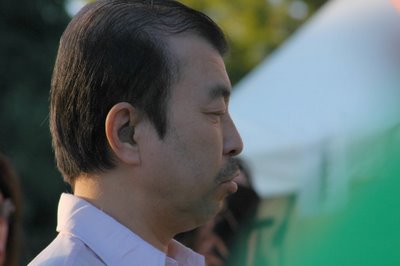
Let say good bye to the light of the last day of this year.
Addio, 2006. さようなら。











 People are Strange
People are Strange Yabusame (流鏑馬) is spectacular rite of mounted archery performed by riders on horseback dressed in the hunting garb of samurai. While speeding along at full gallop, the archers release the reins and fire arrows at three targets. The rite is carried out to ask for bountiful harvests and peace in the world.
Yabusame (流鏑馬) is spectacular rite of mounted archery performed by riders on horseback dressed in the hunting garb of samurai. While speeding along at full gallop, the archers release the reins and fire arrows at three targets. The rite is carried out to ask for bountiful harvests and peace in the world. The Kamakura Period (1192-1338) marked the start of samurai rule in Japan. When government functions were transferred to Kamakura (present day Kamakura City in Kanagawa Prefecture) in the end of the 12th century, the Yabusame rite was performed as the coral Tsurugaoka Hachiman Shrine, which would became an annual official ceremony. After this, the rite spread to the whole country and was widely performed.
The Kamakura Period (1192-1338) marked the start of samurai rule in Japan. When government functions were transferred to Kamakura (present day Kamakura City in Kanagawa Prefecture) in the end of the 12th century, the Yabusame rite was performed as the coral Tsurugaoka Hachiman Shrine, which would became an annual official ceremony. After this, the rite spread to the whole country and was widely performed. The Yabusame rite, after being in full flourish in the Kamakura Period, temporarily faded, but since the 18th century it has been making a comeback and has survived up to the present day.
The Yabusame rite, after being in full flourish in the Kamakura Period, temporarily faded, but since the 18th century it has been making a comeback and has survived up to the present day. First of all, at the sound of a drum, the archers and their attendants line up at the front of the shrine. According to tradition, all movements are proceeded at the signal of drum beats and motion of a fan. Three targets, each a square of hinoki (Japanese cypress) wood measuring 54.5 cm (about 22 in.) along each edge, are set up at intervals beside an approximately 218 m (about 240 yd.) track. In the rite, the mounted archers release the reins and, while riding at full gallop, try to hit all three targets.
First of all, at the sound of a drum, the archers and their attendants line up at the front of the shrine. According to tradition, all movements are proceeded at the signal of drum beats and motion of a fan. Three targets, each a square of hinoki (Japanese cypress) wood measuring 54.5 cm (about 22 in.) along each edge, are set up at intervals beside an approximately 218 m (about 240 yd.) track. In the rite, the mounted archers release the reins and, while riding at full gallop, try to hit all three targets.


 Once upon a time, in the country of Okayama, there lived an old man and an old woman. The old man went everyday into the mountains to cut wood, while his wife would go to the river to wash clothes. One day, while the old woman was down at the river washing clothes, a big peach came floating down the river! It looked so delicious, she decided to take it home for her and her husband to eat. When the old man came back to their home, the old woman cut the peach open, and to their surprise, there was a small boy inside! They decided to call him Momotaro (桃太郎, which can be roughly translated as 'peach boy').
Once upon a time, in the country of Okayama, there lived an old man and an old woman. The old man went everyday into the mountains to cut wood, while his wife would go to the river to wash clothes. One day, while the old woman was down at the river washing clothes, a big peach came floating down the river! It looked so delicious, she decided to take it home for her and her husband to eat. When the old man came back to their home, the old woman cut the peach open, and to their surprise, there was a small boy inside! They decided to call him Momotaro (桃太郎, which can be roughly translated as 'peach boy').